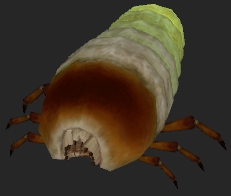npc_antlion_grub
Jump to navigation
Jump to search
 Note:Some keyvalues, spawnflags, effect flags, inputs, or outputs might not affect an NPC, based on the functionality and coding of the NPC.
Note:Some keyvalues, spawnflags, effect flags, inputs, or outputs might not affect an NPC, based on the functionality and coding of the NPC.
| CAntlionGrub |
npc_antlion_grub is a point entity available in ![]() Half-Life 2: Episode Two.
Half-Life 2: Episode Two.
An Antlion grub is a larvae-stage antlion. It emits a faint light and drops a health-nugget upon death.
Keyvalues
- Name (targetname) <string>[ Edit ]
- The name that other entities refer to this entity by, via Inputs/Outputs or other keyvalues (e.g.
parentnameortarget).
Also displayed in Hammer's 2D views and Entity Report.See also: Generic Keyvalues, Inputs and Outputs available to all entities
- Pitch Yaw Roll (Y Z X) (angles) <QAngle>
- This entity's orientation in the world. Pitch is rotation around the Y axis, yaw is the rotation around the Z axis, roll is the rotation around the X axis.
BaseFadeProp:
- Start Fade Dist (fademindist) <float>
- Distance at which the entity starts to fade.
- End Fade Dist (fademaxdist) <float>
- Max fade distance at which the entity is visible.
- If start fade is <0, the entity will disappear instantly when end fade is hit.
- If end fade is <0, the entity won't disappear at all. (This is the default behavior.)
- The values will scale appropriately if the entity is in a 3D Skybox.
- Fade Scale (fadescale) <float>
- If you specify so in worldspawn, or if the engine is running below DirectX 8 (DX7 in
 ), props will fade out even if the fade distances above aren't specified. This value gives you some control over when this happens: numbers smaller than 1 cause the prop to fade out at further distances, while those greater than 1 cause it to fade out at closer distances. Using 0 turns off the forced fade altogether. See also the QC command $noforcedfade.
), props will fade out even if the fade distances above aren't specified. This value gives you some control over when this happens: numbers smaller than 1 cause the prop to fade out at further distances, while those greater than 1 cause it to fade out at closer distances. Using 0 turns off the forced fade altogether. See also the QC command $noforcedfade.
Global:
- Global Entity Name (globalname) <string>
- Name by which this entity is linked to another entity in a different map. When the player transitions to a new map, entities in the new map with globalnames matching entities in the previous map will have the previous map's state copied over their state.
Flags
- 1 : "Do not automatically attach to surface"
Inputs
- Squash
- Squash the grub!
- Agitate <float> !FGD
- The grub will play excited animations and sound effects for this number of seconds.
Outputs
- OnAgitated
- Fired when the grub is stepped on or damaged.
- OnDeath
- Fired when the grub is killed.
- OnDeathByPlayer
- Fired when the grub is killed (only by the player).
